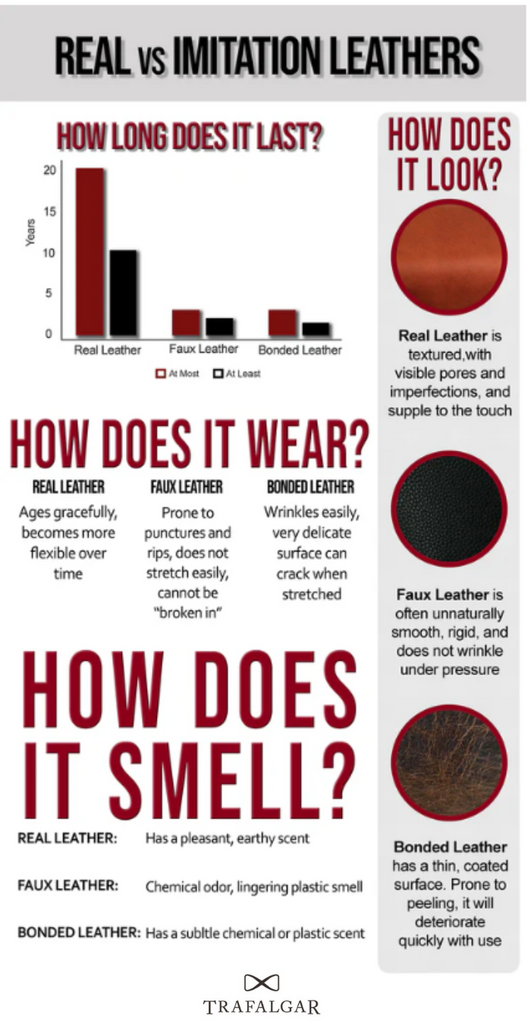
Real vs Faux Leather
With the advent of synthetic alternatives, and increasing environmental concerns, it can be difficult for consumers to decide if real leather or faux leather is right for them. To help, we’ve provided a break-down of some of your options.
What is Faux Leather made out of?
Faux Leather - sometimes referred to as Vegan Leather, Synthetic Leather, or Leatherette - is most commonly made from polyester with a polyurethane or polyvinyl chloride coating. In essence, most Faux Leather is made from plastic. Cheaper faux leathers are often stiff, reeking of plastic, and too shiny. You can’t break in a faux leather jacket or belt in the same manner as real leather, because faux leather does not stretch and wear the way real leather does.
For an in-depth look at how Real Leather is made, see this article.
What is Bonded Leather made out of?
Bonded Leather is often made from the leftovers of real leather production. Scraps of real leather are ground into small pieces and bonded together using a man-made adhesive. This material is then rolled thin and glued to a firm backing to hold it together. The topmost layer of bonded leather is a polyurethane coating usually embossed with a leather pattern.
This may look like real leather, but quickly gets worn down with use, leading to cracking and peeling. Bonded leather is easily rendered unsightly and unusable, but can still legally be referred to as real leather, regardless of what percentage of leather fiber is used.
Is Faux Leather really ethical?
While many people think their faux leather purchase is saving a cow or two, the fact of the matter is that in most cases, they are a purchasing an oil-based alternative that is ultimately harming the environment and affecting the lives of more than just cattle.
While synthetic leather is made without harming animals directly, it comes at a high environmental cost. Synthetic leathers are made from non-renewable resources that require a lot of energy and water. The production often involves the use of carcinogenic chemicals that create harmful greenhouse gas.
Many proponents of vegan leather try to argue the production of real leather has a greater environmental impact than producing synthetic leathers. These statements often include the environmental costs (water usage, methane release) of raising the cattle, and fail to acknowledge that most animal hides are a byproduct of the meat industry.
If simply discarded, animal hides would only add to crowded landfills and dangerous levels of methane production. When animal hides are looked at as a byproduct -meaning an animal is raised specifically for its meat, not its hide, consumption of which will happen regardless- the actual environmental impact of leather production decreases significantly.
Factor in methods like vegetable tanning, and that impact decreases even more.
What about the cost?
While synthetic and bonded leathers can be produced cheaply and quickly, they ultimately last nowhere near as long as real leather. That cheap faux leather bag or bonded leather belt may look nice when you first buy it, but they’ll fall apart quickly. You can easily go through 10 synthetic or bonded leather replacements during the lifespan of real leather goods. Real leather can be a pricey investment, but definitely a worthy one.

